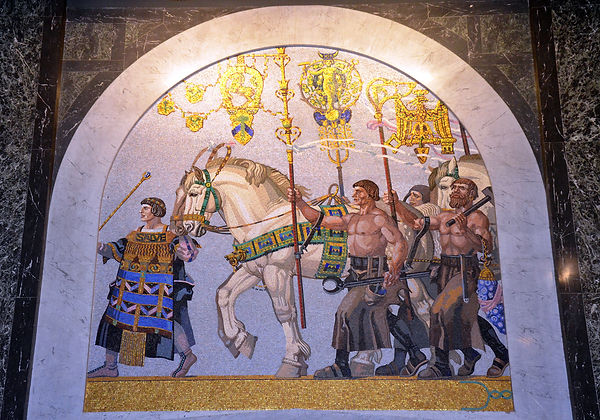<A>
Spitzweg: *
In the Alpine High Valley in Mt. Wendelstein, 1871

<B>
Diez: *
In the New Town Hall Hanover, are 3 black marble panels of mosaics ( a triptych ) of a triumphal procession of Art Nouveau craftsman; subtitled with "craft has golden ground"

<C>
Leibl (Frau Gedon portrait): *
Spengler claims this portrait, all steeped in brown, is the last Old-Master portrait of the West & is painted entirely in the style of the past.

<D>
Palma: *
the Virgin & Child sacra conversazione. This is a genre developed in Italian Renaissance, depiction of the Virgin Mary with the infant Jesus amidst a group of saints, in an informal grouping (as opposed to the more rigid and hierarchical compositions of earlier periods); donor portraits may also be included, generally kneeling, often their patron saint is presenting them to the Virgin, and angels are frequently in attendance. Here we see the Virgin & child with a group of saints and donor, in a horizontal form with landscape background. In other secular groups we see interaction though what is happening is unclear.

<E>
the elder Gabrieli: *
Gabrieli preferred sacred vocal & instrumental music; he never wrote lighter forms (dances); late in his career he concentrated on sacred vocal & instrumental music that exploited sonority for maximum effect. He is credited with the use of dynamics; specifically notated instrumentation; the use of massive forces arrayed in multiple, spatially separated groups. The latter was to be the genesis of the Baroque concertato style which spread quickly to northern Europe. He used the unusual layout of the San Marco church, with its 2 choir lofts facing each other, to create striking spatial effects. Most of his pieces are written so that a choir or instrumental group will first be heard on one side, followed by a response from the musicians on the other side; often there was a 3rd group situated on a stage near the main altar in the centre of the church. Although not original, this polychoral style (first used by Willaert) was advanced by Gabrieli, who deployed specified groups of instruments & singers, with precise directions for instrumentation, and in more than two groups.
See music example
<F>
Venetian music-school: *
A number of factors allowed Venice to emerge. Following the death of Pope Leo X (1521) & the Sack of Rome (1527), the domination of the Roman musical establishment ended; many musicians moved elsewhere or chose not to go to Rome. Venice was attractive. The cathedral of St Marks in Venice was also critical. This cathedral had a unique interior with opposing choir lofts. Owing to this spacious architecture, it was necessary to develop a musical style which exploited the sound-delay, so the Venetian polychoral style was developed. It was an antiphonal, groups of singers and instruments played sometimes in opposition, sometimes together, united by the sound of the organ. Yet another factor which promoted the rich period of musical creativity was printing. In the early 16th century, Venice, prosperous and stable, had become an important centre of music publishing.
The first composer to make use of St Mark’s unique auditory effect was Willaert, maestro di cappella 1527-62. His lone tenure & influence was profound, as a composer & teacher, since most of the Venetians who followed studied with him. Following Willaert, in the 1560s, 2 distinct groups developed: a progressive group, and a conservative group, led by Zarlino who was then maestro di cappella. This latter grouptended to follow the style of Franco-Flemish polyphony & included Cipriano de Rore, Zarlino & Claudio Merulo; members of the progressive group included Donato, Giovanni Croce & later Andrea and Giovanni Gabrieli. The Gabrieli brought the school to its peak in the 1580s. They composed enormous works for multiple choirs, groups of brass, string instruments & organ. These works are the first to include dynamics, the first to include specific instructions for ensemble instrumentation.
<G>
Nietzsche (on Bizet's brown music): *
Extract from "Der Fall Wagner" (The Case of Wagner) - Turin Letter of May, 1888
“This work, too, redeems; Wagner is not the only "redeemer". With it, one says farewell to the humid North, to all water steam of the Wagnerian ideal. Already the plot saves us from it. It still has Merimee's logic in its passion, the shortest line, the hard necessity; it has, above all, what belongs to the hot climate, the dryness of the air, the limpidezza in the air. Here, the climate is changed in every respect. Here, another sensuality speaks, another sensitivity, another serenity. This music is serene, but not of a French or of a German serenity. Its serenity is African; doom is hovering above it, its happiness is brief, sudden, without pardon. I envy Bizet for it that he has had the courage for this sensitivity that has not yet found expression in refined European music--for this more Southern, this browner, more sun-burnt sensitivity... How good the yellow afternoons of its happiness are for us! We look out with it: have we ever seen a smoother sea?--And how this Moorish dance calmingly speaks to us! How, in its lascivious melancholy, even our insatiability reaches the point of satiety, for once!--Finally love, love that is translated back into nature! Love that, in its means, is war, and its basis the deadly hatred of the genders!--I know of no case where the tragical joke that constitutes the essence of love, expresses itself so strictly, so terribly became a formula, as in the last cry of Don Jose, with which the work closes:
Yes, I have killed her
I-- my adored Carmen!